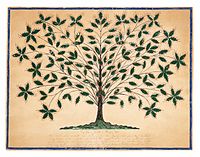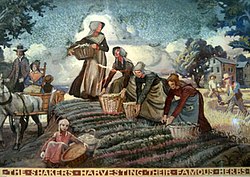The Air B&B, whee I'm staying in Cleveland, is only few blocks from Shaker Heights. My image of Shaker Heights came from reading All The Little Fires. It's not what I pictured. Think of large houses spaced in a forest of tall trees with winding streets. The Shaker Museum was quite modest, which I suppose would be appropriate for a modest sect. Wikipedia, see below, can fill you in on the details of the Shakers.
Bonnie gave us a tour of John Carroll University, where she is Dean of Arts and Sciences. Then she treated us to dinner at her house, about a block from the university. Both her house and the university are in University Heights.
Takk for alt,
Al
Shakers
 Life of the Diligent Shaker, Shaker Historical Society | |
| Total population | |
|---|---|
| 2 | |
| Founder | |
| Ann Lee | |
| Regions with significant populations | |
| Maine, United States | |
| Religions | |
| Shakerism | |
| Scriptures | |
| The Bible, various Shaker texts | |
| Languages | |
| English | |
| Website | |
| maineshakers |
 |
| Topics |
|---|
| Notable people |
Founders
Other members |
The United Society of Believers in Christ's Second Appearing, more commonly known as the Shakers, are a millenarian nontrinitarian restorationist Christian sect founded circa 1747 in England and then organized in the United States in the 1780s. They were initially known as "Shaking Quakers" because of their ecstatic behavior during worship services. Espousing egalitarian ideals, women took on spiritual leadership roles alongside men, including founding leaders such as Jane Wardley, Mother Ann Lee, and Mother Lucy Wright. The Shakers emigrated from England and settled in Revolutionary colonial America, with an initial settlement at Watervliet, New York (present-day Colonie), in 1774. They practice a celibate and communal utopian lifestyle, pacifism, uniform charismatic worship, and their model of equality of the sexes, which they institutionalized in their society in the 1780s. They are also known for their simple living, architecture, technological innovation, music, and furniture.
During the mid-19th century, an Era of Manifestations resulted in a period of dances, gift drawings, and gift songs inspired by spiritual revelations. At its peak in the mid-19th century, there were 2,000-4,000 Shaker believers living in 18 major communities and numerous smaller, often short-lived, communities. External and internal societal changes in the mid- and late-19th century resulted in the thinning of the Shaker community as members left or died with few converts to the faith to replace them. By 1920, there were only 12 Shaker communities remaining in the United States. As of 2019, there is only one active Shaker village: Sabbathday Lake Shaker Village, in Maine.[1] Consequently, many of the other Shaker settlements are now museums.


No comments:
Post a Comment